“Choose safety now; it is a minute’s decision that ensures a lifetime of possibilities. Do not risk the rest of your life for a moment’s oversight.” – Patrick Sevilla, EHS Manager (Devex Incorporated)
Construction sites come with risks, so safety is an important factor. Proper gear is like a life vest for construction workers, keeping them safe from harm.
The Hierarchy of Controls
The idea of controlling dangers at work started way back in the 1950’s. In the United States, the National Safety Council (NSC) came up with a system that eventually became the hierarchy of controls. The idea gained more attention in the 1980’s. It was further developed by the National Institute for Occupational Safety and Health (NIOSH). “Prevention Through Design,” a program in 2007, made the hierarchy of controls official.
This inverted pyramid represents the hierarchy of controls.
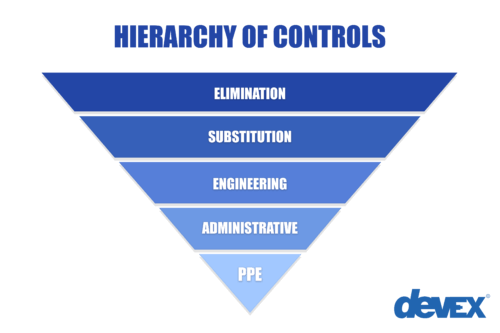
- Elimination. Elimination of hazards is the most preferred method for workplace safety. It focuses on eliminating the hazard itself, as the most effective at minimizing risks. If you can get rid of the dangerous things from the workplace, this will prevent people getting hurt. For example, removing deformed bars scattered on the floor reduced the risk of workers tripping and getting injured.
- Substitution. Substitution follows the principle of replacing a hazardous material or process with a safer alternative. For example, while the worker was using the grinder to cut tiles, he saw that its wire was damaged, and so he used another grinder with its wire in good condition to avoid being shocked by electricity from the damaged wire.
- Engineering Controls. This method focuses on physically changing the environment or equipment to isolate workers from hazards. This involves adding guardrails, barricades, or perimeter blockages to prevent workers from falling.
- Administrative Controls. This focuses on changing the way through policies, procedures, and work practices to minimize worker exposure to hazards. This involves training workers on how to perform safely, setting safe work practices, and using warning signs to highlight dangers.
- Personal Protective Equipment (PPE). Within the hierarchy of controls for workplace safety, PPE represents the last line of defense against hazards. It focuses on providing workers with equipment to protect themselves from hazards after the more effective methods have been explored. Examples of PPE are helmets, gloves, safety glasses, and earplugs.
The hierarchy prioritizes methods that address the hazard using elimination and substitution, or isolate using engineering and administrative controls, before relying on PPE. This is because wearing PPE can be uncomfortable, may limit worker mobility, and can sometimes fail.
In situations where eliminating hazards is impossible, wearing PPE becomes a crucial least effective control measure. Only use PPE approved by the Department of Labor and Employment and Occupational Safety and Health Center.

Head Protection. Hard hats protect the head from falling objects that could cause serious injury, or even death. A tiny object such as a nail, when falling from several storeys high, can cause a life-threatening blood clot or pierce your skull.

Eye Protection. In construction, eye protection shields a worker’s eyes from potential hazards. Safety glasses and UV-proof lenses guard your eyes from small particles and debris. Goggles offer protection during high-risk tasks like cutting wood, where a stray splinter could cause serious injury to the eyes.
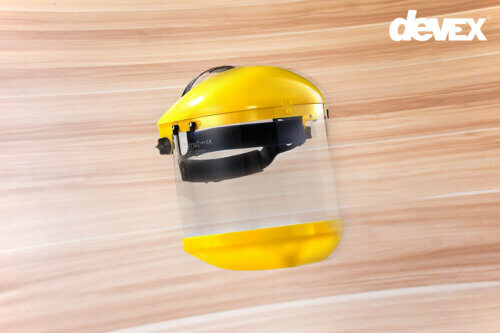
Face Protection. Face protection shields the entire face or specific areas from potential hazards. Construction is dusty and dangerous. Tiny rocks, wood chips, heated metal sparks, and even nails can fly around. Face shields block small objects and protect your face from getting hurt.

Ear Protection. Construction sites are noisy environments due to the use of machinery such as jackhammer, hydraulic jack hammer, grinder, etc. Loud noises can damage your hearing over time. Wear earplugs or earmuffs to block out the noise.
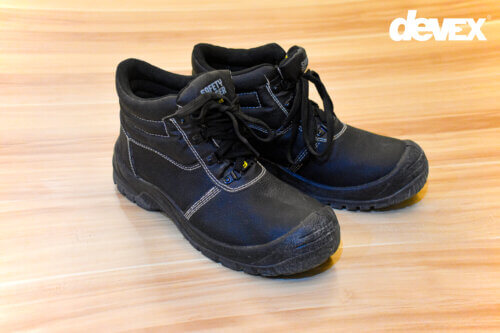
Foot Protection. Safety boots or shoes are designed to protect the workers’ feet from injuries caused by falling or rolling objects, punctures, and impacts. Choose work shoes or boots with a good grip to prevent falls due to slipping. They should also have strong toe guards and soles to protect your feet from heavy objects. Construction areas can be slippery. You might slip on wet ground without the right footwear. With non-skid soles, you will keep your footing and avoid ankle injury.
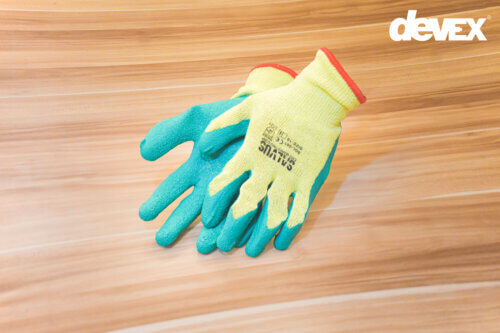
Hand Protection. Trade-specific gloves are designed to shield the hands from hazards and injuries. Wear gloves made of durable materials suited to your specific tasks. They can prevent skin exposure to harmful substances, and can protect the hands from bruises, abrasions, and cuts. Instead of using cotton gloves while doing electrical work, use rubber gloves to prevent getting electrical shock.
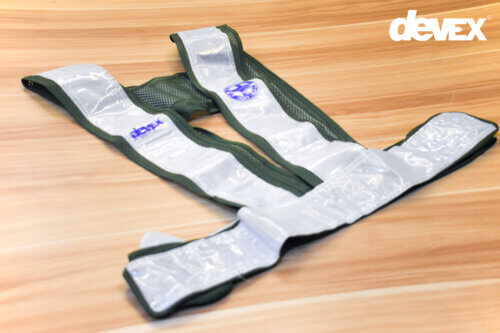
High-Visibility Clothing. Hi-viz clothing or safety vests refer to garments designed to make the wearer clearly visible in low-light conditions or cluttered environments. Construction sites can be dark, especially in the early mornings and in the evenings. Wear a bright vest or clothes with reflective stripes to help others see you. This is especially important when working in or passing by moving equipment.
Neglecting PPE
Wearing PPE might seem inconvenient, but failing to wear them can have serious consequences. Accidents caused by the absence of proper PPE can lead to injuries, triggering investigations, and potential fines. Accidents might delay projects and can further disrupt the project timeline; injured workers require medical attention, while some are unable to immediately return to the job site. The resulting project delays can cost the company significant money. In the worst-case scenario, a severe accident could completely halt construction.
By prioritizing safety and using the right gear, construction workers can minimize risks, avoid costly delays, and make the job site a safe and productive place to be.
Article written by: Christian Kimp Atip
References:
NIOSH. (2024). Centers for Disease Control and Prevention. National Institute for Occupational Safety and Health https://www.cdc.gov/niosh/index.htm
NIOSH | USAGov. (2023). USAGov. National Institute for Occupational Safety and Health https://www.cdc.gov/niosh/about/default.html
NIOSH. (2024). Centers for Disease Control and Prevention. National Institute for Occupational Safety and Health https://www.cdc.gov/niosh/index.htm
Int. Arch. Otorhinolaryngol. 24 (3). (Jul-Sep 202). Why We Need to Use and which Mask Types are Effective against the Novel Coronavirus (COVID-19)? https://www.scielo.br/j/iao/a/wTTd9fRzDx7XTQjtpvsL36d/?lang=en#
Raken. (2014–2024). Elimination of Hazards Toolbox Talk https://www.rakenapp.com/features/toolbox-talks/elimination-of-hazards


Comments are closed here.